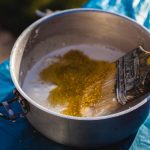Do you know that the global textile industry is expected to reach a value of over 1.23 trillion U.S. dollars by 2025?
Understanding which fabrics can be effectively glued together is essential for achieving professional-quality results in your projects. Whether you're a seasoned crafter or a budding fashion designer, the ability to bond different fabrics opens up a world of creative possibilities.
By mastering the properties of various textiles and selecting the appropriate adhesive, you can seamlessly join fabrics like cotton, denim, silk, and more.
This guide will provide you with the knowledge and techniques needed to create durable and visually stunning fabric combinations through the art of gluing.
Key Takeaways
- Tight weave and natural fibers like cotton or silk bond well with adhesives.
- Synthetic fibers such as polyester or nylon can be effectively bonded with special treatment or specific adhesives.
- Highly porous fabrics like felt or fleece may absorb too much adhesive, affecting bond strength.
- Non-porous fabrics like vinyl or coated materials may require specific adhesives for a strong bond.
Understanding Fabric Properties
When you're determining which fabrics can be effectively glued together, it's important to understand their properties and how they'll interact with the adhesive. Fabric properties play a crucial role in determining the success of fabric bonding. Material science has identified several key factors that influence the adhesion of fabrics when using glue.
The first consideration is the weave and fiber content of the fabric. Fabrics with a tight weave and natural fibers like cotton or silk generally bond well with adhesives. Synthetic fibers such as polyester or nylon can also be effectively bonded, but their smooth surface may require special treatment or specific adhesives for optimal results.
Another important aspect is the porosity of the fabric. Highly porous fabrics like felt or fleece may absorb too much adhesive, affecting the bond strength. Conversely, non-porous fabrics like vinyl or coated materials may require adhesives specifically designed to create a strong bond.
Understanding these fabric properties and adhesion factors is essential for successful fabric bonding. By considering these material science principles, you can confidently select the right adhesive for your specific fabric bonding needs.
Suitable Fabric Combinations
When choosing fabrics to glue together, it's important to consider their compatibility. Certain fabrics work well together, creating strong bonds, while others may not adhere as effectively.
Understanding common fabric pairings and applying the right glue technique can make a significant difference in the success of your project.
Fabric Compatibility Guide
You can often successfully glue together fabrics that are compatible in terms of fiber content and weave. Material compatibility is crucial for effective fabric bonding. Here's a guide to help you understand which fabrics are suitable for gluing together:
| Fabric 1 | Fabric 2 | Compatibility |
|---|---|---|
| Cotton | Linen | Excellent |
| Wool | Silk | Good |
| Polyester | Nylon | Good |
| Rayon | Acetate | Fair |
| Spandex | Leather | Poor |
Common Fabric Pairings
Successfully gluing fabrics together often depends on finding common fabric pairings with compatible fiber content and weave, allowing for effective bonding based on material compatibility.
Some common fabric pairings that work well for fabric bonding are cotton to cotton, polyester to polyester, and wool to wool. These material combinations are suitable for gluing because they've similar fiber content, making them more likely to adhere to each other.
Additionally, pairing fabrics with similar weaves, such as twill to twill or satin to satin, can also result in successful fabric bonding.
When selecting fabric combinations for gluing, it's essential to consider both the fiber content and weave to ensure the best possible adhesion. By paying attention to these factors, you can achieve strong and durable fabric bonding.
Glue Application Tips
To achieve effective fabric bonding, pair fabrics with compatible fiber content and weave, ensuring a strong and durable adhesion. When applying glue to fabric, consider the following tips for optimal results:
- Choose the Right Glue: Select a glue type suitable for the specific fabrics you're bonding, such as fabric glue for delicate materials or epoxy for heavy-duty fabrics.
- Even Application: Apply the glue evenly across the fabrics to ensure full coverage and a strong bond.
- Drying Time: Allow the glued fabrics to dry according to the instructions provided with the chosen adhesive. Patience during the drying process is crucial for a secure bond.
- Pressure and Support: After applying the glue, press the fabrics together firmly and use supporting materials such as clips or weights to maintain pressure during the drying time.
Choosing the Right Adhesive
When selecting an adhesive for fabric, consider the specific type of fabric and the intended use to ensure a strong and durable bond. Different fabrics require different bonding techniques and adhesives. Here's a helpful table to guide you in choosing the right adhesive for your fabric:
| Fabric Type | Recommended Adhesive |
|---|---|
| Cotton | Fabric glue, fusible web |
| Denim | Fabric glue, hot glue |
| Silk | Fabric glue, spray adhesive |
| Leather | Leather glue, contact cement |
| Polyester | Spray adhesive, fabric glue |
| Wool | Fabric glue, fusible web |
Keep in mind that the intended use of the fabric also plays a role in adhesive selection. For example, if the fabric will be washed frequently, a waterproof fabric glue or an adhesive specifically designed for washable fabrics should be used. Always test the adhesive on a small, inconspicuous area of the fabric before applying it to the entire project to ensure compatibility. By carefully considering the fabric type and its intended use, you can select the right adhesive for a strong and lasting bond.
Preparation and Testing
Before you start gluing fabrics together, it's important to conduct compatibility testing and properly prepare the surfaces.
This involves assessing how the fabrics interact with the adhesive and ensuring that the surfaces are clean and free from any substances that could hinder adhesion.
Fabric Compatibility Testing
You can conduct fabric compatibility testing by applying a small amount of fabric glue to a corner of the fabric and pressing it firmly to another piece of fabric. This simple test allows you to assess the compatibility of different fabrics before committing to a larger project.
Here's a step-by-step guide:
- Select Test Fabrics: Choose the fabrics you want to test for compatibility.
- Apply Fabric Glue: Use a small amount of fabric glue on a corner of one fabric.
- Press Firmly: Press the glued corner firmly onto another piece of fabric.
- Observe and Assess: After allowing the fabrics to dry, check for fabric adhesion and material bonding.
Surface Preparation Techniques
Assess fabric compatibility through careful surface preparation and testing. Proper fabric handling is crucial before applying adhesives. Ensure the fabric is clean, free of any dirt, dust, or residue that may hinder adhesion. For smooth surfaces, gently sand or roughen the area to create texture for better adhesive bonding. Conversely, delicate fabrics require a more cautious approach to avoid damage.
Test the adhesive on a small, inconspicuous area of the fabric to assess its compatibility and any potential adverse effects. Additionally, consider adhesive selection based on the fabric type and intended application. Conduct thorough research or seek professional advice to choose the most suitable adhesive for your specific fabric and project.
Techniques for Gluing Fabrics
When gluing fabrics together, it's essential to select the appropriate adhesive for the specific types of fabric you're working with. To ensure a strong and durable bond, follow these techniques:
- Fabric Compatibility: Before applying any adhesive, ensure that the fabrics you intend to glue together are compatible. Some adhesives work better with certain fabrics, so it's crucial to check for compatibility.
- Adhesive Selection: Choose the right adhesive based on the type of fabric you're working with. For example, if you're bonding heavy fabrics like denim or canvas, a strong epoxy adhesive may be suitable. For delicate fabrics such as silk or chiffon, a gentle fabric glue is more appropriate.
- Surface Preparation: Prepare the fabric surfaces by ensuring they're clean and free from any dirt, oils, or residues. This will help the adhesive bond more effectively.
- Application Technique: Follow the manufacturer's instructions for applying the adhesive. Apply the glue evenly and ensure that it covers the entire bonding area for a secure hold.
Tips for Long-Lasting Bonds
To ensure long-lasting bonds when gluing fabrics together, consistently assess the fabric compatibility and select the appropriate adhesive for each specific type of fabric. Proper application of adhesive plays a vital role in the longevity of the bond. Here are some tips to help you achieve a durable bond:
| Fabric Type | Compatible Adhesive |
|---|---|
| Cotton | Fabric glue, fusible web |
| Denim | Fabric glue, epoxy |
| Silk | Fabric glue, spray adhesive |
| Leather | Leather glue, contact cement |
When gluing fabrics together, make sure to apply the adhesive evenly and allow it to set according to the manufacturer's instructions. Effective adhesives bond well when the fabric surfaces are clean and free from any residues. Additionally, applying pressure to the bond and allowing sufficient drying or curing time will contribute to a strong and long-lasting adhesion. Always test a small area first to ensure the chosen adhesive is suitable for the specific fabric type. By following these tips and using effective adhesives, you can create durable bonds that withstand the test of time.
Considerations for Specific Projects
How can you determine the best adhesive for your specific fabric project?
When considering fabric bonding and material compatibility for your project, it's crucial to take into account the following key factors:
- Fabric Type: Different fabrics have varying textures and compositions which can affect how well they bond with adhesives. For example, cotton and polyester may require different adhesives due to their different properties.
- Project Requirements: Consider the specific demands of your project, such as whether the bonded fabric will be subject to washing, stretching, or exposure to different environmental conditions. This will help you choose an adhesive that can withstand these challenges.
- Adhesive Properties: Look for adhesives specifically designed for fabric bonding. Consider factors such as flexibility, washability, and drying time. Understanding the properties of the adhesive will help you choose the most suitable one for your project.
- Testing: Always test a small sample of the fabrics and adhesive together before starting your project. This will help you ensure that the chosen adhesive provides the desired bond without damaging the fabric.
Frequently Asked Questions
Can I Use Regular School Glue to Bond Fabrics Together?
You can't use regular school glue to bond fabrics together effectively. Using fabric glue is recommended for a strong, durable bond. When deciding between sewing and gluing fabric, consider the durability and flexibility needed for your project.
Are There Any Fabrics That Cannot Be Glued Together at All?
When bonding fabrics, consider fabric compatibility and potential issues. Some fabrics, like waterproof and heavy-duty materials, may not bond well with glue. For these, consider alternative bonding methods like sewing for a more secure hold.
How Long Does It Take for Fabric Adhesive to Fully Cure and Create a Strong Bond?
When using fabric adhesive, the drying time can vary depending on the specific product. Typically, it takes around 24 hours for the adhesive to fully cure and create a strong bond. This bond provides durability for your fabric projects.
Can I Wash Fabrics That Have Been Glued Together Without Damaging the Bond?
You can wash bonded fabrics, but be cautious. Follow fabric adhesive safety precautions and wait for the curing time. Avoid using school glue for fabric bonding; opt for fabric adhesive to preserve the fabric bond.
Are There Any Safety Precautions I Should Take When Working With Fabric Adhesives?
When working with fabric adhesives, take safety precautions seriously. Ensure proper ventilation to avoid inhaling fumes. Avoid skin contact with the adhesive and wear gloves if necessary. Always follow the manufacturer's guidelines for safe usage.
- How Does Ring Spun Cotton Affect Garment Fit and Shape Retention? - August 13, 2024
- What Are the Challenges in Producing Ring Spun Cotton? - August 13, 2024
- Is Ring Spun Cotton Suitable for Plus-Size Clothing? - August 13, 2024







